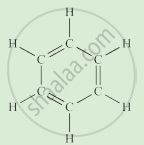Advertisements
Advertisements
प्रश्न
Distinguish between ionic and covalent compounds under the following properties:
(i) Strength of forces between constituent elements
(ii) Solubility of compounds in water
(iii) Electrical conduction in substances
उत्तर
(i) The forces of attraction between the constituent elements (positive and negative ions) of ionic compounds are stronger than the forces of attraction between the constituent elements of covalent compounds.
(ii) Ionic compounds are soluble in polar solvents such as water and are insoluble in non-polar solvents such as petrol, kerosene, etc.
Covalent compounds on the other hand dissolve readily in organic solvents such as alcohol and acetone, but are insoluble in polar compounds.
(iii) Ionic compounds conduct electricity in their molten state or aqueous form, whereas covalent compounds do not conduct electricity.
APPEARS IN
संबंधित प्रश्न
Choose the most appropriate answer from the following list of oxides which fit the description.
A covalent oxide of a metalloid.
Which inert gas electron configuration do the Cl atoms in Cl2 molecule resemble? What is this electron configuration?
What type of chemical bonds are formed by carbon? Why?
Friedrich Wohler converted an inorganic compound into an organic compound in the laboratory.
Write the name and formula of organic compound formed.
Describe the structure of diamond. Draw a simple diagram to show the arrangement of carbon atoms in diamond.
The solution of one of the following compounds will not conduct electricity. This compounds is:
(a) NaCl
(b) CCl4
(c) MgCl2
(d) CaCl2
Buckminsterfullerene is an allotropic form of the element:
(a) phoshorus
(b) fluorine
(c) carbon
(d) sulphur
A hydrocarbon having one double bond has 100 carbon atoms in its molecule. The number of hydrogen atoms in its molecule will be
(a) 200
(b) 198
(c) 202
(d) 196
Give two example in following case:
Gaseous polar compounds
Draw an electron dot structure of the following molecule. (Without showing the circle) :
Methanol
The covalent bond in which the electrons are shared equally between the combining atoms.
Give reason as to why hydrogen chloride can be termed as a polar covalent compound.
The molecule which contains a triple covalent bond is ______.
Explain the following:
Water is a polar covalent molecule.
Element A has 2 electrons in its M shell. Element B has atomic number 7.
If B is a diatomic gas, write the equation for the direct combination of A and B to form a compound.
Potassium chloride is an electrovalent compound, while hydrogen chloride is a covalent compound, But, both conduct electricity in their aqueous solutions. Explain.
Write the molecular formula of the given compound.
Propylene
Write scientific reason.
Carbon has the property of forming many compounds.
Complete the following activity.
Write the names of the hydrocarbons for the following structural formula.
(isobutylene, cyclohexane, propene, cyclohexene, cyclopentane, benzene, propyne, isobutane, propane)
 |
The correct structural formula of butanoic acid is
